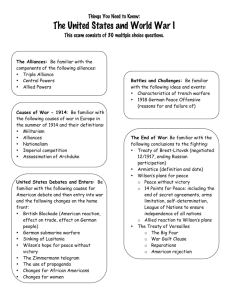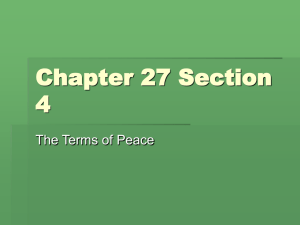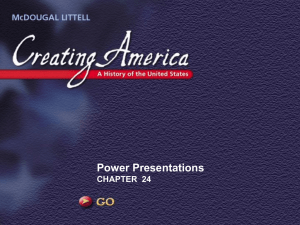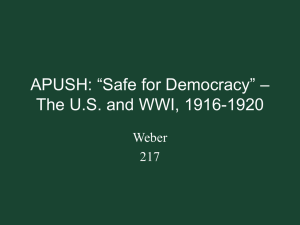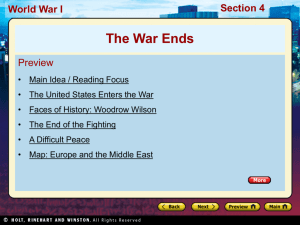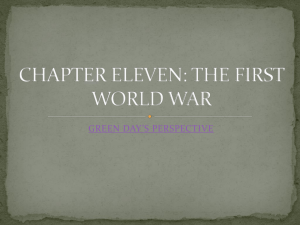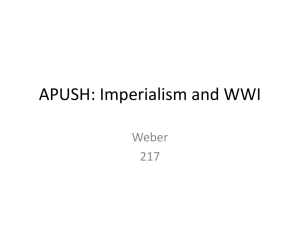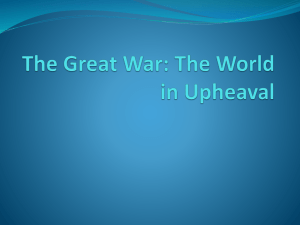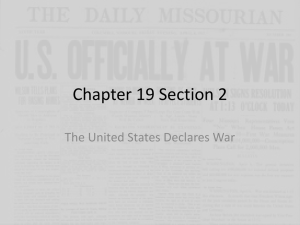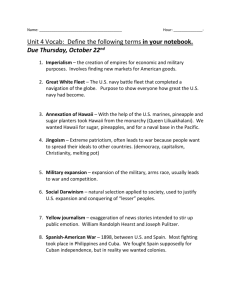Chapter 19
advertisement
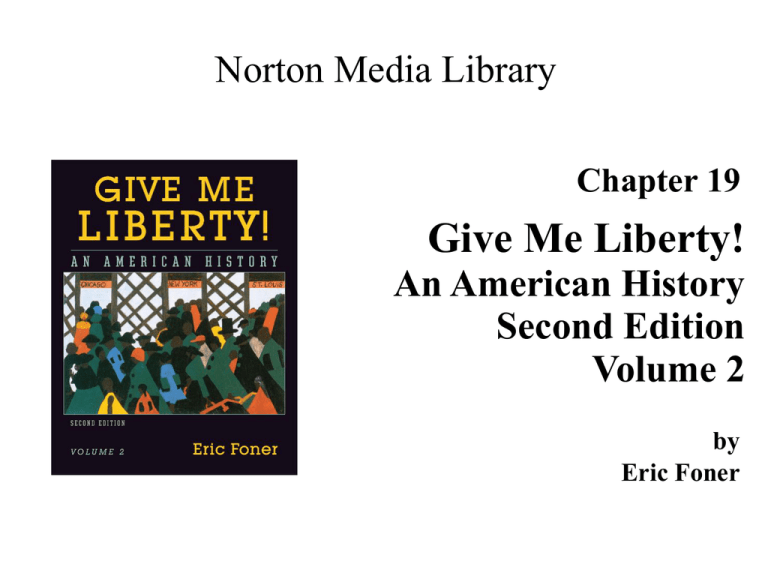
Norton Media Library Chapter 19 Give Me Liberty! An American History Second Edition Volume 2 by Eric Foner Norton Media Library Chapter 19 Give Me Liberty! An American History Second Edition Volume 2 by Eric Foner I. A. B. C. D. An era of intervention W. T. Snead’s The Americanization of the World Theodore Roosevelt and Roosevelt Corollary (Panama Canal) William Howard Taft and Dollar Diplomacy Woodrow Wilson’s“moral imperialism” (see quote, page 680 & 685) 1. Mexico a. Mexican Revolution under leadership of Francisco Madero b. Assassination of Madero and outbreak of Civil War c. Wilson dispatches troops, skirmishes with Pancho Villa II. America and the Great War A. Outbreak of European war 1. Assassination of Archduke Franz Ferdinand 2. Allied Powers (Britain, France, Russia, Japan) versus Central Powers (Germany, Austria-Hungary, Ottoman Empire) 3. Protracted, bloody stalemate B. Implications of European war 1. Undermining of faith in human progress and reason 2. Indication of power of nationalism in modern world II. America and the Great War (cont’d) C. American Response 1. Mixed sentiments a. Sympathy for Allied Powers 1) British roots 2) Association of Britain with democracy, Germany with tyranny b. Opposition to Allied Powers, and/or U.S. involvement 1) German, Irish, Russian (anti-czarist) roots 2) Antiwar feminists, pacifists, social reformers II. America and the Great War (cont’d) C. American Response 2. The road to American involvement a. Initial declaration of neutrality b. British and German blockades c. American business ties to Britain d. Sinking of Lusitania e. “Preparedness” policy f. German suspension of submarine warfare against neutrals g. Reelection of Wilson; “He Kept Us Out of War” h. German resumption of open submarine warfare i. Zimmerman Note j. First Russian Revolution (Menshevik); overthrow of czar k. American declaration of war against Germany II. America and the Great War (cont’d) D. From American to Armistice 1. Second Russian Revolution (Bolshevik) a. Vladimir Lenin’s break with Allies b. Withdrawal of Russia from war 2. Wilson’s Fourteen Points 3. Defeat of German advance; Allied counteroffensive 4. German surrender (11/11/1911) III. The war at home (cont’d) A. Expansion of federal powers 1. Military conscription (Selective Service Act, 1917) 2. Economic intervention a. Areas 1) War production (War Industries Board – Bernard Baruch) 2) National transportation (Railroad Administration) 3) Coal and oil (Fuel Administration) 4) Farming and food preparation (Food Administration) 5) Labor relations (National War Labor Board) b. Varied degrees of intervention 1) Coordination of overall war production (WIB) 2) Control of some sectors (coal, oil, labor relations) III. The war at home (cont’d) B. Expansion of federal powers 2. Economic intervention c. Partnership between business and government 1) Guaranteed profit 2) Suspension of anti-trust d. Labor-management-government cooperation 1) Uninterrupted production 2) Federal mediation 3) Labor’s right to organize 4) Improved wages and working conditions 3. Raising of revenue 1) Corporate and income tax increases 2) Liberty bonds III. The war at home (cont’d) C. Propaganda war 1. Widespread opposition to American entry a. Industrial Workers of the World b. Socialist party 2. Committee on Public Information; George Creel a. Modes of propaganda 1) Pamhlets 2) Posters 3) Advertisements 4) Motion pictures 5) Four-Minute speeches b. Themes 1) Social cooperation 2) Expanded democracy and freedom 3) Demonization of Germans III. The war at home (cont’d) D. Revitalization of Progressive causes 1. Women’s suffrage a. Optimism that wartime patriotism will gain women the vote b. Insistence that women should enjoy “democracy” at home 1) National Women’s party 2) Alice Paul c. Support from Wilson d. Postwar ratification of Nineteenth Amendment (1920) III. The war at home (cont’d) D. Revitalization of Progressive causes 2. Prohibition a. Sources of support 1) Employers 2) Urban reformers 3) Women 4) Anti-immigration Protestants 5) Anti-Germans b. Progress 1) Passage of state laws 2) Postwar ratification of Eighteenth Amendment (1920) III. The war at home (cont’d) E. Repression of dissent 1. Instruments a. Federal government 1) Espionage Act 2) Sedition Act b. State governments c. Vigilante organizations 2. Themes a. Definition of “patriotism” as support for government, war, economic status quo b. Definition of “un-Americanism” as labor radicalism, opposition to war (see Emma Goldman quote, page 697) III. The war at home (cont’d) E. Repression of dissent 3. Means a. Criminalization of dissent; conviction of Eugene V. Debs b. Investigations of suspected dissidents c. Mass arrests d. Public harassment and intimidation e. Suppression of labor protest f. Terror 4. Minimal reaction from Progressives III. The war at home (cont’d) G. Status and response of African-Americans 1. Progressive era a. Roosevelt, Wilson, and Race 1) Birth of a Nation b. W. E. B. Du Bois and revival of black protest 1) Du Bois background 2) The Souls of Black Folk a) Challenge to Booker T. Washington’s accommodationism 3) “Talented tenth” 4) Niagara movement (1905), see Du Bois quote, pg. 707 5) NAACP (1909) III. The War at Home (cont’d) H. Status and response of African-Americans 2. World War I era a. Optimism that wartime patriotism would gain blacks equal rights 1) “Close ranks” 2) Minimal gains b. Great migration (1910: 90% black population in S) 1) Scale and direction (see table, page 709) 2) Motivations and aspirations 3) Disappointing realities c. Anti-black violence, North and South d. New spirit of militancy 1) Silent Protest Parade 2) Garveyism (see quote, page 710) a) Universal Negro Improvement Association IV. 1919 A. Labor upheaval in America 1. Breadth and magnitude 2. Spirit and themes a. Appropriation of wartime rhetoric of freedom and democracy b. Social and ideological diversity B. Labor upheaval in America IV. 1919 (cont’d) B. Labor upheaval in America 1. Red Scare a. Methods 1) Federal raids on officers of labor and radical organizations; Palmer Raids 2) Arrests 3) Deportations 4) Secret Files b. Outcomes 1) Devastation of labor and radical organizations 2) Broad outrage over abuse of civil liberties V. Forging of postwar international order A. Wilson’s performance abroad 1. Rapturous reception in Paris 2. Hardheaded diplomacy at Versailles B. Treaty of Versailles 1. Wilsonian elements a. League of Nations b. New sovereign nations in Europe: Finland, Poland, Czechoslovakia, Austria, Hungary, Latvia, Lithuania, Estonia, Yugoslavia 2. Harsher elements a. French occupation of Saar Basin and Rhineland b. Germany 1) Restrictions on German military 2) Crippling reparations for Germany: $33-56 billion 3) War guilt clause V. Forging of postwar international order (cont’d) B. Treaty of Versailles 1. Limits of national sovereignty a. Denial of independence for French and British colonies b. League of Nations “mandates” for former Ottoman lands c. Reallotment of former German colonies C. Seeds of instability for twentieth-century world D. Wilsonian internationalism in postwar America 1. Short term setbacks a. League of Nations debate b. Wilson’s stroke, incapacity c. Senate rejection of Versailles treaty d. Eclipse of Progressivism; “return to normalcy”

